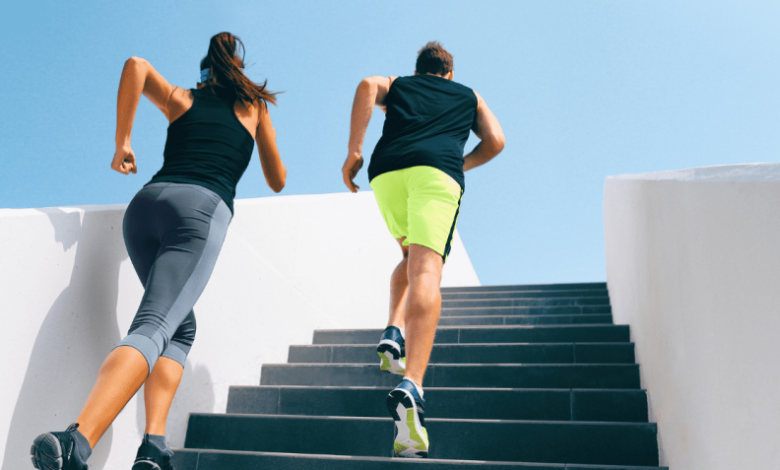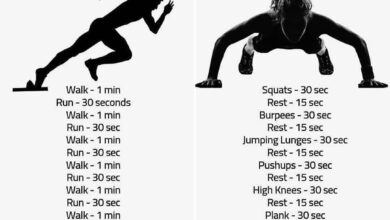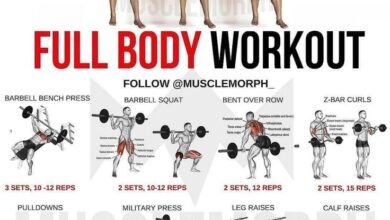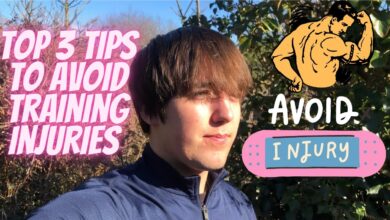
How Short Bursts of Exercise Can Benefit Your Health
How short bursts of exercise can benefit your health – We all know exercise is good for us, but what if I told you that even short bursts of intense activity could deliver a powerful punch to your health? It’s true! Short bursts of exercise, also known as high-intensity interval training (HIIT), can pack a serious punch when it comes to improving your physical and mental well-being.
This isn’t just about getting a quick workout in, it’s about maximizing your time and effort for a more impactful and enjoyable fitness experience.
Imagine a world where you could squeeze in a workout in just a few minutes, without sacrificing results. That’s the beauty of short bursts of exercise. From boosting your energy levels and strengthening your heart to sharpening your mind and improving your sleep, the benefits are truly remarkable.
So, are you ready to discover how even short bursts of exercise can transform your life?
The Science Behind Short Bursts of Exercise
Short bursts of exercise, also known as high-intensity interval training (HIIT), have gained immense popularity for their effectiveness in improving overall health and fitness. But what makes these short, intense workouts so beneficial? Let’s delve into the science behind it.
Physiological Mechanisms
Short bursts of exercise trigger a cascade of physiological changes that contribute to improved health. The body’s response to intense exercise is primarily driven by the release of hormones like adrenaline and cortisol. Adrenaline, also known as epinephrine, is a powerful hormone that increases heart rate, blood pressure, and blood flow to muscles, preparing the body for action.
Cortisol, on the other hand, helps regulate blood sugar levels and provides energy for sustained effort.
Impact on Cardiovascular Health
Short bursts of exercise have a profound impact on cardiovascular health. Studies have shown that HIIT can significantly improve heart rate variability, a measure of the heart’s ability to adapt to changes in demand. This improved variability indicates a healthier cardiovascular system, reducing the risk of heart disease.
Moreover, short bursts of exercise can help lower blood pressure and improve blood flow, further promoting heart health.
Muscle Strength and Endurance
Short bursts of exercise can lead to significant gains in muscle strength and endurance. The intense nature of HIIT workouts stimulates muscle protein synthesis, leading to muscle growth and increased strength. Additionally, HIIT workouts improve the body’s ability to utilize oxygen, enhancing endurance.
Benefits for Physical Health
Short bursts of exercise, also known as high-intensity interval training (HIIT), offer numerous benefits for physical health. These benefits extend beyond weight management and include improvements in cardiovascular health, bone density, and overall fitness.
Weight Management
Short bursts of exercise can be effective for weight management by increasing calorie expenditure and boosting metabolism. When you engage in short bursts of intense exercise, your body continues to burn calories even after the workout is over. This is known as the “afterburn effect” or EPOC (excess post-exercise oxygen consumption).
“Studies have shown that HIIT workouts can burn more calories in a shorter amount of time compared to moderate-intensity exercise.”
The increased calorie expenditure, combined with the metabolic boost, can lead to significant weight loss or weight maintenance over time.
You don’t need to spend hours at the gym to see results. Short bursts of exercise, like a 10-minute HIIT workout, can boost your metabolism and energy levels. To make sure you’re fueling your body for those workouts, consider incorporating an RD-approved approach to eating for fullness and satisfaction, like the one outlined in this article an rd approved approach to eating for fullness and satisfaction.
By combining smart eating with short bursts of exercise, you can achieve a healthier and more energized lifestyle.
Cardiovascular Health
Short bursts of exercise can significantly improve cardiovascular health, reducing the risk of heart disease and stroke. By engaging in high-intensity intervals, you strengthen your heart muscle, improve blood circulation, and lower blood pressure.
“Regular HIIT workouts can increase HDL (good) cholesterol levels and decrease LDL (bad) cholesterol levels, contributing to a healthier cardiovascular system.”
These benefits contribute to a lower risk of developing cardiovascular diseases.
Even a few minutes of intense exercise can make a huge difference in your overall health. You’ll boost your metabolism, improve your mood, and even sleep better. Just remember to be mindful of the common thinking traps to avoid when trying to lose weight so you don’t sabotage your efforts.
Short bursts of exercise are a great way to get started and see real results, so don’t let anything hold you back!
Bone Density
Short bursts of exercise can positively impact bone density, reducing the risk of osteoporosis, especially in older adults. High-intensity exercise stimulates bone growth and strengthens the skeletal system.
“Weight-bearing exercises, like running, jumping, and strength training, are particularly effective in improving bone density.”
Short bursts of these types of exercises can be incorporated into a routine to promote bone health and reduce the risk of fractures.
Benefits for Mental Health
Beyond the physical benefits, short bursts of exercise can significantly enhance your mental well-being. Regular, even brief, physical activity can act as a powerful stress reliever, boost your mood, and improve cognitive function.
The Impact of Short Bursts of Exercise on Stress and Anxiety
Engaging in short bursts of exercise can effectively reduce stress and anxiety levels. When you exercise, your body releases endorphins, which have mood-boosting effects and act as natural painkillers. Exercise can also help to distract you from your worries and anxieties, providing a temporary escape from stressful thoughts.
The Influence of Short Bursts of Exercise on Mood and Cognitive Function
Short bursts of exercise can have a positive impact on your mood and cognitive function. Exercise can increase blood flow to the brain, which can improve cognitive function and boost your mood. Regular exercise can also help to reduce symptoms of depression and anxiety.
Short bursts of exercise, like a quick walk or a few sets of squats, can be a great way to boost your energy levels and improve your overall health. To make sure you’re fueling those workouts properly, consider incorporating a Mediterranean diet with a low-carb twist, ways to make the mediterranean diet low carb friendly can help you stay satisfied and energized for those short bursts of exercise.
The Relationship Between Short Bursts of Exercise and Improved Sleep Quality
Research suggests that short bursts of exercise can improve sleep quality. Regular exercise can help to regulate your sleep-wake cycle, making it easier to fall asleep and stay asleep. However, it’s important to avoid exercising too close to bedtime, as this can make it harder to fall asleep.
Incorporating Short Bursts into Your Routine
You might be thinking, “Great, short bursts of exercise are beneficial, but how do I actually fit them into my busy day?” Don’t worry, it’s easier than you think. There are plenty of ways to incorporate short bursts of high-intensity exercise into your daily routine without drastically changing your lifestyle.
Sample Workout Routine
A sample workout routine that incorporates short bursts of high-intensity exercise can be as simple as this:
- Warm-up: 5 minutes of light cardio, like jogging in place or jumping jacks.
- High-intensity interval: 30 seconds of intense exercise, like burpees, mountain climbers, or sprint running.
- Rest: 30 seconds of rest or light activity.
- Repeat steps 2 and 3 for 8-10 rounds.
- Cool-down: 5 minutes of stretching.
This routine can be adjusted to fit your fitness level and time constraints. You can increase the duration of the high-intensity intervals or the number of rounds as you get stronger.
Everyday Activities with Short Bursts
Many everyday activities can be adapted to include short bursts of exercise. Here are a few examples:
- Walking:Instead of walking at a steady pace, try alternating between brisk walking and jogging for short intervals.
- Taking the Stairs:Skip the elevator and take the stairs whenever possible. You can even add in a few squats or lunges while you’re at it.
- Housework:Turn up the music and add some intensity to your cleaning routine. Do some squats while you vacuum or lunges while you dust.
- Commuting:Get off the bus or train a stop early and walk the rest of the way. You can also try jogging or biking to work a few days a week.
Staying Motivated and Consistent
Staying motivated and consistent with any exercise routine can be challenging. Here are a few tips for making short bursts of exercise a regular part of your life:
- Set Realistic Goals:Start with small, achievable goals, and gradually increase the intensity or duration of your workouts as you get fitter.
- Find an Activity You Enjoy:If you enjoy the activity, you’re more likely to stick with it. Experiment with different types of exercise until you find something that you look forward to doing.
- Make It a Habit:Schedule time for your short bursts of exercise, just like you would any other important appointment. Treat it as a non-negotiable part of your day.
- Find a Workout Buddy:Having a workout partner can help you stay motivated and accountable. You can also encourage each other and make it more fun.
- Track Your Progress:Keeping track of your workouts can help you see how far you’ve come and stay motivated to keep going. Use a fitness tracker, a journal, or a fitness app to track your progress.
Examples of Short Burst Exercise: How Short Bursts Of Exercise Can Benefit Your Health
Short burst exercise, also known as high-intensity interval training (HIIT), is a popular and effective way to improve your fitness in a short amount of time. These workouts involve alternating between periods of intense exercise and short rest periods, maximizing calorie burn and improving cardiovascular health.
Types of Short Burst Exercise, How short bursts of exercise can benefit your health
Here are some common types of short burst exercise:
| Exercise Type | Duration | Intensity Level | Equipment Required | Target Muscle Groups |
|---|---|---|---|---|
| HIIT (High-Intensity Interval Training) | 15-30 minutes | High | None or minimal | Full body |
| Tabata | 4 minutes | Very high | None or minimal | Full body |
| Sprint Intervals | 10-20 minutes | High | Track or treadmill | Legs, glutes, core |
Considerations for Short Bursts of Exercise
While short bursts of exercise offer numerous benefits, it’s crucial to approach them with awareness and consideration. Just like any form of physical activity, incorporating short bursts into your routine requires a mindful approach to ensure safety and maximize results.
Importance of Warm-up and Cool-down
Before engaging in short bursts of exercise, a proper warm-up is essential to prepare your body for the upcoming activity. This involves gradually increasing your heart rate and blood flow, preparing your muscles for exertion. A warm-up could include light cardio, dynamic stretches, or a combination of both.
For example, a 5-minute brisk walk or some arm circles and leg swings can effectively warm up your body.Similarly, a cool-down routine after your short bursts is crucial for helping your body recover and prevent muscle soreness. This involves gradually decreasing your heart rate and stretching your muscles.
A 5-minute light walk or gentle stretching can help your body transition back to a resting state.
Potential Risks and Contraindications
While short bursts of exercise are generally safe, individuals with underlying health conditions should consult with their healthcare providers before starting any new exercise program. Certain conditions, such as cardiovascular disease, respiratory problems, or musculoskeletal issues, may require modifications or restrictions.
For instance, individuals with high blood pressure may need to avoid high-intensity bursts and opt for lower-intensity activities.
Listening to Your Body and Adjusting Exercise Intensity
It’s essential to listen to your body and adjust your exercise intensity based on your fitness level and any existing health conditions. If you experience any pain, discomfort, or shortness of breath during your short bursts, stop and rest.
Remember, the goal is to challenge yourself while respecting your body’s limitations.
- Start with shorter bursts and gradually increase the duration and intensity as you become more comfortable.
- Listen to your body and adjust the intensity based on your current fitness level and health conditions.
- If you experience any pain, discomfort, or shortness of breath, stop and rest.
Final Thoughts

Incorporating short bursts of exercise into your routine doesn’t have to be a daunting task. It can be as simple as adding a few minutes of intense activity to your daily walks or incorporating quick bursts of high-intensity exercise into your existing workout routine.
Remember, it’s all about consistency and finding what works best for you. So, get ready to experience the power of short bursts of exercise and unlock a healthier, happier, and more vibrant you.






